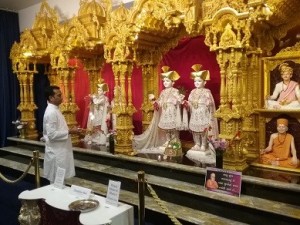On the 13th of August 2016, Pramukh Swami, the President and guru of the transnational Hindu movement Swaminarayan BAPS, died in his 95th year. Just over two weeks earlier, I had been doing a recce in the Swaminarayan BAPS Mandir (temple) in Preston for a film sequence we are making for our latest module (Exploring Religion). The devotion of members of the community to their guru was evident in almost everything they said. Even more poignant in the light of events was their hope that, although Pramukh Swami had been in poor health for some years, they would yet have the joy of celebrating his 100th birthday in five years’ time.
I only learnt of Pramukh Swami’s death when the community contacted us to postpone the actual filming. What struck me almost immediately was that I had not learnt of this through the British media. Still in the media’s so-called ‘silly season’ during the peak holiday period and the summer recess of parliament, I checked with several people closely involved in the study of religions, but none recollected having seen or heard any mention of Pramukh Swami’s death in the British media. Newspapers in India, of course, were full of the news of the death of this major Hindu personality. I did come across tweets of condolence from a few British politicians, including the Prime Minister and the Leader of the Opposition, and later found an appreciation of Pramukh Swami’s life by Mark Tully (dated 29th August) in the online Guardian. But I waited in vain for wider coverage in the British media, other than in outlets specifically designed to serve British Asian communities such as Asian Image and Eastern Eye.
The British Hindu community, although often said to lack the media profile of some other religious groups in Britain, is a large and active one. Swaminarayan BAPS is currently the most dynamic strand of the Swaminarayan tradition with a highly visible presence in Britain because of its flagship mandir in Neasden (inspired by Pramukh Swami). Pramukh Swami, who had led Swaminarayan BAPS as President (from 1950) and then guru since 1971, had a global standing, and not just because of his temple-building, which had earned him a place in the Guinness Book of Records. Just as many Britons now have known no monarch other than Queen Elizabeth II, who came to the throne in 1952, so too, many Swaminarayan BAPS devotees have lived their whole lives under the inspiration and guidance of this one guru.
The limited interest shown by the media in Britain in the death of Pramukh Swami, an event of monumental significance for a large number of British Hindus, is surely revealing. Not about ISIS nor the wearing of burqas nor about gender and sexual politics in the Church of England, perhaps his death simply was not deemed ‘newsworthy’? Odd, really, when accounts of transgressions by gurus in India have previously found their way into British newspapers, although these gurus have had far less impact on British society than Pramukh Swami.
[I have delayed this blog as it would have been inappropriate to post this kind of reflection in the days immediately after the death of Pramukh Swami, although this is the period to which the blog refers.]
Gwilym Beckerlegge

